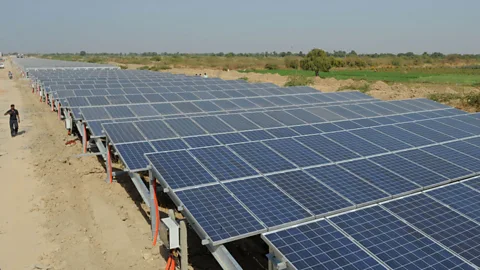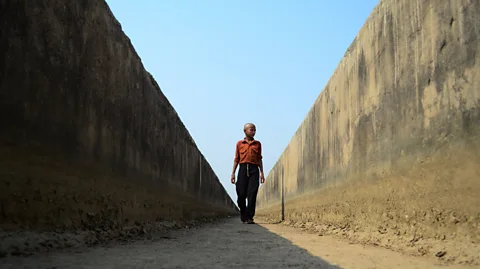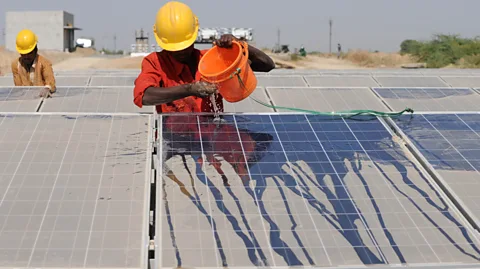The ‘solar canals’ making smart use of India’s space
 Getty Images
Getty ImagesSolar energy is clean, but it usually takes up huge tracts of land. In India, an alternative is turning the country’s canals into glittering trails of solar panels.
As the harsh midday sun beats down on a small, dusty village in Gujarat, western India, lines of blue solar panels on steel support structures snake their way to the horizon. The panels cover the top of irrigation canals, gleaming like iridescent mirrors. This small village of 40 homes with thatched walls and tin roofs, and lumbering stray cows, was one of rural India’s many communities who, until recently, did not have electricity. But now a lamp lights each home so children can study at night, and farmers can milk their cows long after sunset.
India has relied traditionally on coal-fired power plants, which generated 72% of the country’s electricity in 2018-19. India’s combination of abundant sunshine – about 300 sunny days in a year – and a large energy-hungry population makes it an ideal location for solar. The country’s solar capacity reached 36.6GW at the end of the first quarter of 2020, with the aim of growing to 100GW by 2022.
But one of the main challenges in building solar farms is finding the right place to do it. Land is relatively expensive in India and often has multiple owners, so the purchase of land involves many formalities. India’s high population density also puts pressure on the land, with an average of 464 people per square kilometre. Rooftop solar panels are one solution, but sunny space atop buildings is limited too.
In Gujarat, the answer has been to cover its canals with solar panels, as a solution that saves land, water and carbon emissions in one.
You might also like:
In the last few years, the solar energy market's focus has shifted from large-scale utility projects, to smaller projects that make more innovative use of space, says Payal Saxena, manager of strategy consulting at Gensol Engineering, and canal-top solar is a prime example.
 Getty Images
Getty ImagesA pilot 750m stretch in Gujarat in 2014 led to the first large-scale canal-top solar power plant in the Vadodara district of Gujarat in 2015, at a cost of $18.3 million. The long stretch of the canals leading off the Narmada River enables electricity to be extracted at multiple points, says Manik Jolly, chief executive of Grassroots and Rural Innovative Development, who was involved in the first Narmada River canal project.
The energy generated from the solar canal can provide electricity for farmers during the energy-intensive irrigation season, and out of season the electricity can be fed into the state grid, sold to distribution companies or used by the canal authority, says Jolly. Since this power is generated in a rural area, the transmission losses are reduced and the local grid is strengthened.
Since the first solar canal project, a number of others have been commissioned in India, including a 100MW canal-top solar power project atop the branch canals off the Narmada River, stretching for a distance of 40km, at an estimated cost of 1bn Indian rupees ($13.9m/£9.3m).
Overall, Gujarat has more than 80,000km of canals meandering through the state. According to Gujarat State Electricity Corporation, if 30% of this were converted to solar, 18,000MW of power could be produced, saving 90,000 acres of land.
Mutual benefit
The advantages of solar plants atop canals are not just about local energy production and land saved. For one thing, solar power plants can be built much faster than large coal or gas power stations. For another, the covering over the canal helps to prevent evaporation of water, leaving more available for crops and people.
 Getty Images
Getty ImagesIn states like Gujarat, Rajasthan and Maharashtra, where canals are mainly used for irrigation, evaporation is a big problem, notes Pulkit Dhingra, founding director of Ahmedabad-based AHA Solar Photovoltaics.
Another plus of the panels’ shade is curbing algal blooms in the canals. Algae growth can clog water pumps and cause toxicity. “With the installation of the solar panels, and absence of direct sunlight, algae growth is drastically minimised,” says Nilesh Kumar, senior project officer at the Gujarat Energy Research and Management Institute.
And while the water can benefit from the solar panels above, so do the panels from the water below. The running water helps the panels to remain cool, which increases their efficiency by at least 2.5-5%. There are some drawbacks, however. Canal-top plants are more expensive to construct than normal solar plants. The supports have to be galvanised with a protective zinc layer because the water below increases the risk of corrosion. Finding the right location is difficult too, as the width of the canal has to be just right, says Dhingra. Too wide, and the construction becomes difficult and expensive. Too narrow, and the number of panels that can be constructed are too few to absorb enough sunshine. And of course there has to be sufficient stretch of canal to accommodate the planned solar structure.
 Getty Images
Getty ImagesAnd, like solar panels placed on land or rooftops, the panels must be cleaned regularly as electricity production declines if dust collects on top of them. The operation and maintenance of canal-top projects is a big challenge, as ramps have to be built to enable cleaning, says Jolly. Some companies use sprayers and robots to clean the panels in remote areas. “Because canal-top plants are spread over large areas and cannot be protected by boundary walls or fencing, security concerns are major – cameras may have to be installed to monitor pilferage,” adds Gensol Engineering’s Payal Saxena.
The meandering nature of the canals also imposes restrictions. To maximise the absorption of energy, the solar panels should face south, but the canal’s direction cannot be dictated. Solar panels also act as an obstruction to repair the canals or remove silt, and very often trees along the canal have to be cut down as the areas have to be shadow-free.
So far, eight Indian states have commissioned canal solar projects. “These innovative projects can provide cheap and consistent electricity to millions of farmers and improve their profits,” says Jolly. And there is more potential to maximise renewable power from India’s canals, if solar farms above were combined with hydro-power from below, as researchers such as Sabah Usmani, an analyst at the Environmental Defense Fund, have suggested.
With their water-cooled efficiency, and mutual benefits for the canals that run beneath, it looks likely that these snaking, glittering solar canals will become a much more common sight in India.
--
The emissions from travel it took to report this story were 0kg CO2. The digital emissions from this story are an estimated 1.2g to 3.6g CO2 per page view. Find out more about how we calculated this figure here.
--
If you liked this story, sign up for the weekly bbc.com features newsletter, called “The Essential List”. A handpicked selection of stories from BBC Future, Culture, Worklife, and Travel, delivered to your inbox every Friday.
